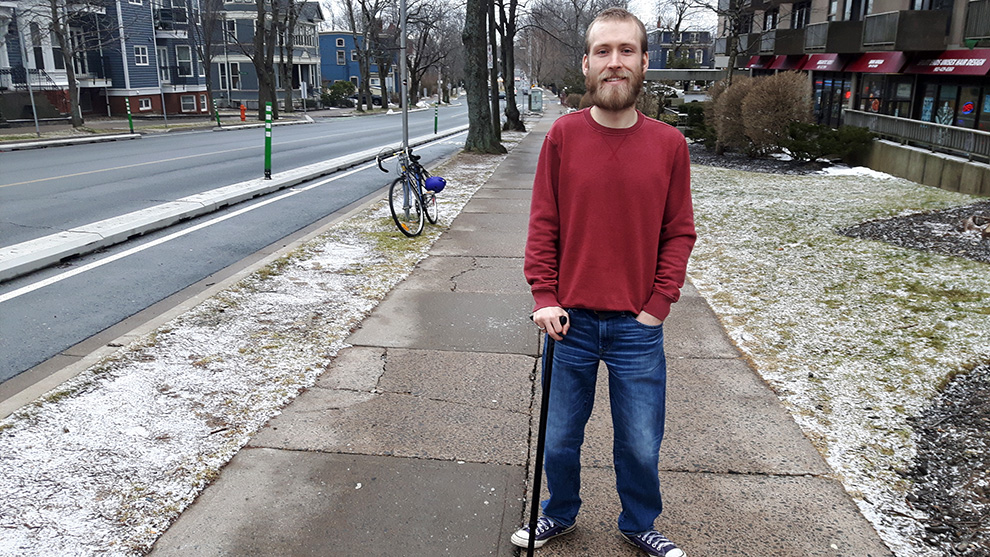Halifax disability advocates raise awareness for invisible illnesses
3 in 5 Canadians with disabilities have fluctuating symptoms, report says

caption
Colin Kibenge-MacLeod poses with his cane.April Hubbard parked her car in an accessible parking spot at Dalhousie University. She hung her accessible parking permit, and walked around the back to pull out her wheelchair. But before she could do that, a stranger emerged from a nearby building — running, shouting, and ready to lash out.
“He got pretty nasty with me, confronting me,” Hubbard says.
“I pointed to the accessible permit, I tried to have a conversation with him, but he just wasn’t willing to hear it. And yeah, he got really, really upset, to the point that I just had to get the chair out and wheel away.”
Hubbard, 34, has a tethered spinal cord. It’s a deteriorative condition, and she is gradually losing the use of her leg. She started off using forearm crutches but now uses a wheelchair most of the time.
That incident in the parking lot was 10 years ago, but Hubbard says when she gets out of her wheelchair, she is still often met with anger and confusion.
“People, after they get to know me, will joke that they thought I was faking when they first met me,” Hubbard says.
Report challenges mainstream views of disability
People with disabilities who struggle with a range of changing symptoms, or who face scrutiny for switching mobility aids, often feel misunderstood.
According to Statistics Canada’s 2017 Survey on Disability, 6.2 million Canadians over the age of 15 self-identify as having a disability. And at 30.4 per cent of the population, Nova Scotia has the highest percentage of people with disabilities in all of Canada.
A report published last month shows that 61 per cent, or three out of five Canadians with disabilities experience dynamic symptoms that change over time. The report contrasts these dynamic disabilities with “continuous disabilities,” which generally remain more stable.
“Typically when we talk about disabilities in general, we tend to think of something that’s quite static and quite permanent. Where that came from, I can’t say,” says Stuart Morris, a lead author on the report.
While Nicki Himmelman, 46, hasn’t had outright confrontations with strangers, she has been glared at for parking in accessible parking spots.
She has Ehlers-Danlos syndrome and psoriatic arthritis, and her symptoms change from day to day. Sometimes, she doesn’t use any mobility aids. But when her pain is acting up, or she thinks the day’s activities will exhaust her, she switches between using a cane, a walker and a wheelchair.
“Mostly my main concern areas are chronic pain, leg supplication and dislocations of my joints. So I can be walking and my hip will pop out, or I can be reaching up on a shelf and my shoulder will come out,” says Himmelman, vice-president of the Atlantic Ehlers-Danlos Syndrome Society.
Colin Kibenge-MacLeod, 29, also alternates his mobility aids. Amongst other diagnoses, he was born with spina bifida occulta.
Kibenge-MacLeod points out that when some people see someone in a wheelchair, they often assume that person is “wheelchair-bound when in fact, that’s not always the case.”
He’s never dealt with a confrontation, but he’s endured a few glares. He says people can get confused when he switches between aids.
“I like to see the glass half full,” Kibenge-MacLeod says. “They’re trying to understand me as much as I can try to understand somebody else.”
“People want to know that you’re sick. They want to know that you’re in a wheelchair. They want something visual and concrete that they can understand.”
Different kinds of disabilities
Like Himmelman, Lloyd wishes for more awareness of “invisible illnesses” — disabilities that may not be outwardly obvious.
Kibenge-MacLeod wants to highlight that there are many different kinds of disabilities.
“Just because I have a disability doesn’t make me the exact same as everybody else in the disabled community,” he says.
Hubbard, too, wants the public to recognize and appreciate more fully “a variety and spectrum of disability.”
“The world doesn’t really understand how to see us and navigate that situation yet,” she says.
“But yeah, you talk to us — we’ll help you through it.”
About the author
Andrea McGuire
Andrea McGuire is a journalism student from Newfoundland. Before coming to King's College, she completed a master's degree in folklore at Memorial...

B
Barb
D
Dave Burchell
D
Deb Sanderson